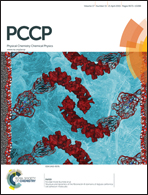A rational computational study of surface defect-mediated stabilization of low-dimensional Pt nanostructures on TiN(100)†
Abstract
Platinum is known as a catalyst with exceptional reactivity for many important reactions, e.g. the oxygen reduction reaction. To reduce the high cost of pure platinum catalysts, platinum on a carbon support is widely used in industrial fuel cell applications. However, these Pt/C systems suffer from poor stability. As a cost-efficient and more durable alternative, Pt single-atom catalysts on a TiN support have recently been suggested, and it has been shown that the single-atom catalysts are stable when anchored at a nitrogen vacancy site on the TiN surface in a nitrogen-lean environment. To further explore the perspective of Pt/TiN catalytic systems, we provide insights into the stability and morphology of Pt nanostructures at the TiN(100) surface, using a density-functional theory approach in combination with ab initio atomistic thermodynamics. Our results show that the formation of two-dimensional Pt nano-layers is preferred over the formation of three-dimensional Pt nano-clusters on the TiN substrate. Similar to the single-atom catalysts, nano-layers of Pt can be stabilized on the TiN(100) surface by surface nitrogen vacancies under nitrogen-lean conditions. By analyzing the electronic metal–support interaction (EMSI) between the Pt nano-layer and the TiN surface with surface defects, we demonstrate that a strong EMSI between the surrounding Ti and Pt atoms is important for stabilizing the catalyst nano-layer at the TiN surface, and that N vacancies lead to stronger Pt–Ti interaction. This work provides a rational computational platform for the design of new generation high-performance Pt-based fuel cells.


 Please wait while we load your content...
Please wait while we load your content...